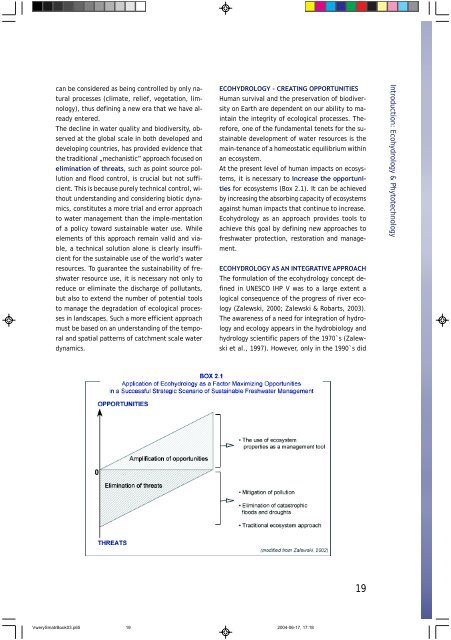Manual - International Environmental Technology Centre
Manual - International Environmental Technology Centre
Manual - International Environmental Technology Centre
You also want an ePaper? Increase the reach of your titles
YUMPU automatically turns print PDFs into web optimized ePapers that Google loves.
can be considered as being controlled by only natural<br />
processes (climate, relief, vegetation, limnology),<br />
thus defining a new era that we have already<br />
entered.<br />
The decline in water quality and biodiversity, observed<br />
at the global scale in both developed and<br />
developing countries, has provided evidence that<br />
the traditional „mechanistic” approach focused on<br />
elimination of threats, such as point source pollution<br />
and flood control, is crucial but not sufficient.<br />
This is because purely technical control, without<br />
understanding and considering biotic dynamics,<br />
constitutes a more trial and error approach<br />
to water management than the imple-mentation<br />
of a policy toward sustainable water use. While<br />
elements of this approach remain valid and viable,<br />
a technical solution alone is clearly insufficient<br />
for the sustainable use of the world’s water<br />
resources. To guarantee the sustainability of freshwater<br />
resource use, it is necessary not only to<br />
reduce or eliminate the discharge of pollutants,<br />
but also to extend the number of potential tools<br />
to manage the degradation of ecological processes<br />
in landscapes. Such a more efficient approach<br />
must be based on an understanding of the temporal<br />
and spatial patterns of catchment scale water<br />
dynamics.<br />
ECOHYDROLOGY - CREATING OPPORTUNITIES<br />
Human survival and the preservation of biodiversity<br />
on Earth are dependent on our ability to maintain<br />
the integrity of ecological processes. Therefore,<br />
one of the fundamental tenets for the sustainable<br />
development of water resources is the<br />
main-tenance of a homeostatic equilibrium within<br />
an ecosystem.<br />
At the present level of human impacts on ecosystems,<br />
it is necessary to increase the opportunities<br />
for ecosystems (Box 2.1). It can be achieved<br />
by increasing the absorbing capacity of ecosystems<br />
against human impacts that continue to increase.<br />
Ecohydrology as an approach provides tools to<br />
achieve this goal by defining new approaches to<br />
freshwater protection, restoration and management.<br />
ECOHYDROLOGY AS AN INTEGRATIVE APPROACH<br />
The formulation of the ecohydrology concept defined<br />
in UNESCO IHP V was to a large extent a<br />
logical consequence of the progress of river ecology<br />
(Zalewski, 2000; Zalewski & Robarts, 2003).<br />
The awareness of a need for integration of hydrology<br />
and ecology appears in the hydrobiology and<br />
hydrology scientific papers of the 1970`s (Zalewski<br />
et al., 1997). However, only in the 1990`s did<br />
VwerySmatrBook03.p65 19<br />
2004-06-17, 17:18<br />
19<br />
Introduction: Ecohydrology & Phytotechnology

















